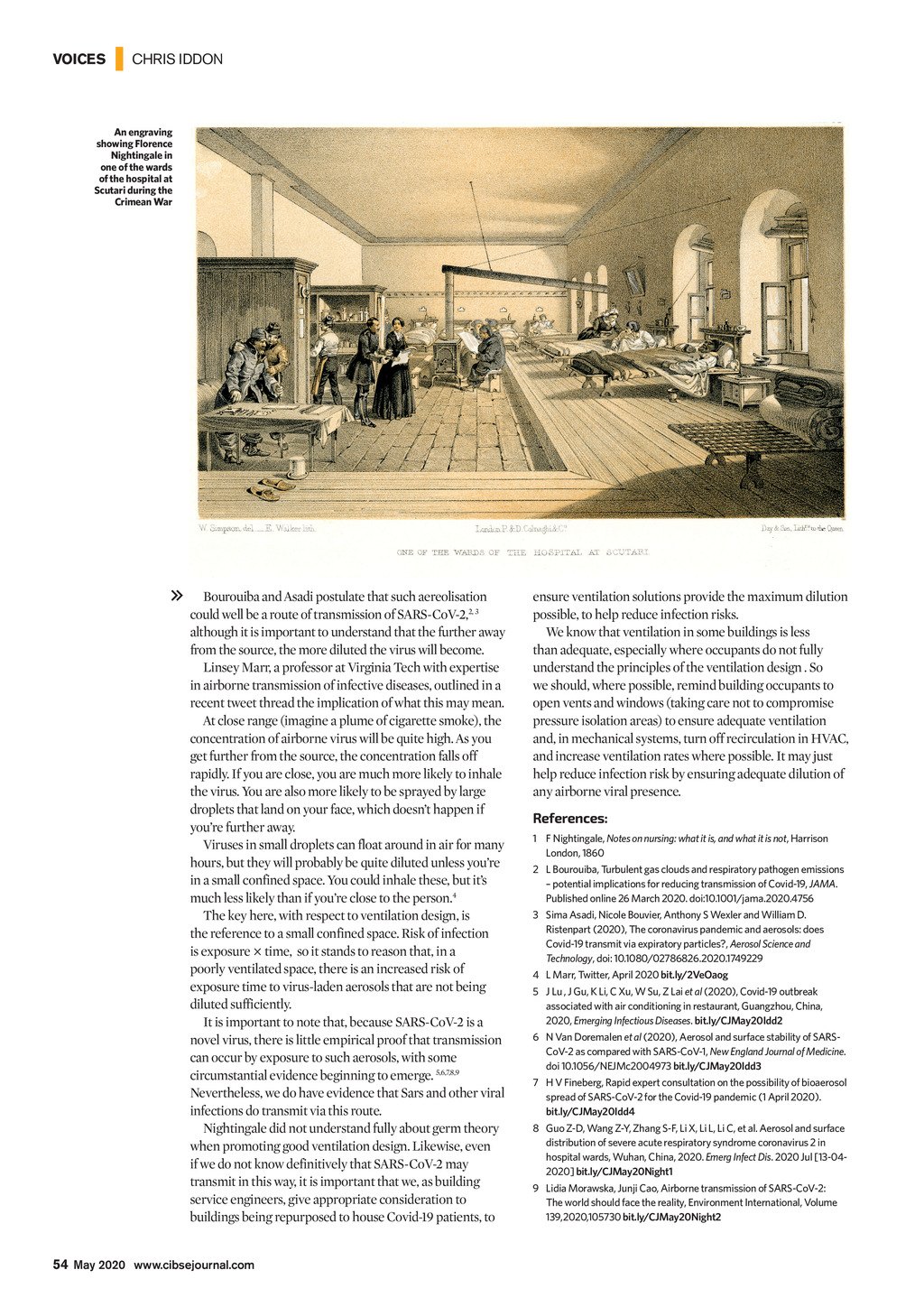




VOICES | CHRIS IDDON An engraving showing Florence Nightingale in one of the wards of the hospital at Scutari during the Crimean War Bourouiba and Asadi postulate that such aereolisation could well be a route of transmission of SARS-CoV-2,2, 3 although it is important to understand that the further away from the source, the more diluted the virus will become. Linsey Marr, a professor at Virginia Tech with expertise in airborne transmission of infective diseases, outlined in a recent tweet thread the implication of what this may mean. At close range (imagine a plume of cigarette smoke), the concentration of airborne virus will be quite high. As you get further from the source, the concentration falls off rapidly. If you are close, you are much more likely to inhale the virus. You are also more likely to be sprayed by large droplets that land on your face, which doesnt happen if youre further away. Viruses in small droplets can float around in air for many hours, but they will probably be quite diluted unless youre in a small confined space. You could inhale these, but its much less likely than if youre close to the person.4 The key here, with respect to ventilation design, is the reference to a small confined space. Risk of infection is exposure time, so it stands to reason that, in a poorly ventilated space, there is an increased risk of exposure time to virus-laden aerosols that are not being diluted sufficiently. It is important to note that, because SARS-CoV-2 is a novel virus, there is little empirical proof that transmission can occur by exposure to such aerosols, with some circumstantial evidence beginning to emerge. 5,6,7,8,9 Nevertheless, we do have evidence that Sars and other viral infections do transmit via this route. Nightingale did not understand fully about germ theory when promoting good ventilation design. Likewise, even if we do not know definitively that SARS-CoV-2 may transmit in this way, it is important that we, as building service engineers, give appropriate consideration to buildings being repurposed to house Covid-19 patients, to ensure ventilation solutions provide the maximum dilution possible, to help reduce infection risks. We know that ventilation in some buildings is less than adequate, especially where occupants do not fully understand the principles of the ventilation design . So we should, where possible, remind building occupants to open vents and windows (taking care not to compromise pressure isolation areas) to ensure adequate ventilation and, in mechanical systems, turn off recirculation in HVAC, and increase ventilation rates where possible. It may just help reduce infection risk by ensuring adequate dilution of any airborne viral presence. References: 1 F Nightingale, Notes on nursing: what it is, and what it is not, Harrison London, 1860 2 L Bourouiba, Turbulent gas clouds and respiratory pathogen emissions potential implications for reducing transmission of Covid-19, JAMA. Published online 26 March 2020. doi:10.1001/jama.2020.4756 3 S ima Asadi, Nicole Bouvier, Anthony S Wexler and William D. Ristenpart (2020), The coronavirus pandemic and aerosols: does Covid-19 transmit via expiratory particles?, Aerosol Science and Technology, doi: 10.1080/02786826.2020.1749229 4 L Marr, Twitter, April 2020 bit.ly/2VeOaog 5 J Lu , J Gu, K Li, C Xu, W Su, Z Lai et al (2020), Covid-19 outbreak associated with air conditioning in restaurant, Guangzhou, China, 2020, Emerging Infectious Diseases. bit.ly/CJMay20Idd2 6 N Van Doremalen et al (2020), Aerosol and surface stability of SARSCoV-2 as compared with SARS-CoV-1, New England Journal of Medicine. doi 10.1056/NEJMc2004973 bit.ly/CJMay20Idd3 7 H V Fineberg, Rapid expert consultation on the possibility of bioaerosol spread of SARS-CoV-2 for the Covid-19 pandemic (1 April 2020). bit.ly/CJMay20Idd4 8 G uo Z-D, Wang Z-Y, Zhang S-F, Li X, Li L, Li C, et al. Aerosol and surface distribution of severe acute respiratory syndrome coronavirus 2 in hospital wards, Wuhan, China, 2020. Emerg Infect Dis. 2020 Jul [13-042020] bit.ly/CJMay20Night1 9 L idia Morawska, Junji Cao, Airborne transmission of SARS-CoV-2: The world should face the reality, Environment International, Volume 139,2020,105730 bit.ly/CJMay20Night2 54 May 2020 www.cibsejournal.com CIBSE May20 pp53-54 Chris Iddon.indd 54 24/04/2020 16:39